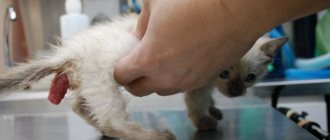What does a lice eater look like?
The cat lice beetle (Felicola subrostratus) is a parasite that lives on the surface of the animal's skin. It is the causative agent of diseases such as mallophagosis or trichodectosis. They feed on keratin particles of skin, fur, secretions of the sebaceous glands, as well as blood that appears from wounds when combing. They are also called chewing lice because, unlike regular lice, they do not suck blood.
Lice eaters in cats resemble lice, which is clearly visible in the photo. They have a small oval body (1-2 mm) and a quadrangular shield-shaped head. They look translucent due to their light gray, yellowish color. Each of the parasite's 3 pairs of legs has hooks that help it cling to hairs and skin. Gnawing type mouth.
Lice eaters do not like to change their owner. The female lays up to 60 eggs and glues them to the hair roots with a special secretion. It is impossible to remove eggs from wool by hand. After 1-1.5 weeks, larvae hatch from the eggs. After another 2-3 weeks, insects appear. How quickly the parasite develops and matures depends on the conditions. So, in winter, when the cat’s undercoat is especially thick and therefore warm, lice eaters develop faster. The entire life cycle of the parasite takes a month.
Outside the host's body, lice eaters live no more than 5 days.
Treatment of trichodectosis in cats
The following are used in the treatment of trichodectosis:
- preparations for external treatment - destroy lice eaters: drops on the withers - convenient form, very easy to use, ensures the destruction of lice eaters and long-term protection against them: Frontline Spot On;
- Stronghold;
- Leopard;
- Fiprex;
- Advantage;
- In-Up Complex;
- Frontline;
- Rolf Club;
- Flickar;
- Neostomozana;
- Tavegil;
- Sinulox;
- Itraconazole;
- Milbemax;
- Gamavit;
Video: treatment for external parasites of pets
Preparations for external treatment
Effective means for external treatment against lice:
| A drug | Compound | Operating principle | Price, rub |
| Frontline Spot-On; drops on the withers | Fipronil | Kills parasitic insects and mites 24–48 hours after application. Protects against repeated attacks by lice for 4–6 weeks. Do not bathe for 48 hours after treatment. Can be used by pregnant and lactating women. Not allowed for kittens under 8 weeks | 466 |
| Stronghold, drops on the withers | Selamectin | Destroys parasitic insects, skin mites and roundworms. Kills eggs and larvae. Can be used by pregnant and lactating women. Not allowed for kittens under 6 weeks. You can wash your cat 2 hours after use. The action lasts 1 month | from 330 |
| Leopard, drops on the withers | Fipronil, diflubenzuron, dicarboximide | Destroys adult and larval forms of parasitic insects and mites. The protective effect lasts 1 month. Not for pregnant, lactating, kittens under 8 weeks. Do not bathe for 3 days after application | from 162 |
| Frontline, spray | Fipronil | Destroys parasitic insects and ticks. Protection against insects for up to 40 days. You cannot bathe 2 days before use, as well as 2 days after it. Suitable for pregnant and lactating cats, kittens from 2 days of age | 970 for 100 ml |
| Rolf Club, shampoo | Permethrin | Destroys parasitic insects. Not for lactating kittens under 2 months | 315 for 400 ml |
| Phytoelite, shampoo | Permethrin, decoctions of wormwood and celandine | 107 for 220 ml |
First, spray or drops are applied; then wait the time specified in the instructions for the drug and bathe the cat with medicated shampoo.
Photo gallery: preparations for external treatment against lice eaters
Frontline spray can be used in pregnant and lactating cats, as well as in kittens from 2 days of age
Bars drops protect against attacks by ticks and parasitic insects
Stronghold destroys parasitic insects, skin mites and roundworms
Traditional medicine
Traditional medicine can be used at the early stage of lice-eater infestation, when the number of parasites is still small and there are no signs of complications. Repeated bathing of the pet in decoctions is used:
- wormwood;
- chamomile;
- successions.
The bathing product is prepared as follows:
- Take 100 g of dry grass or 600 g of fresh.
- Pour in two liters of boiling water.
- Boil over very low heat for 15 minutes or keep for half an hour in a water bath.
- Remove from heat or water bath.
- Leave for an hour.
- Strain.
- Add water to the required volume and bathe the pet.
Photo gallery: traditional medicine for treatment against lice
Wormwood infusion is used for bathing cats to get rid of parasitic insects
An infusion of string is used for bathing in cases of minor infestation by lice eaters.
Chamomile infusion requires several applications when bathing to get rid of lice in case of minor infestation
Features of treatment of pregnant cats and kittens
It is important to prevent the development of lice-eater infestation in pregnant cats and kittens, since they have the highest risk of complications due to physiological immunodeficiency. Pregnant cats with trichodectosis necessarily infect newborn kittens. Trichodectosis in kittens is very difficult, they are stunted in growth, and secondary infectious complications often occur that can lead to death. Both pregnant cats and kittens from 2 days of age can use Frontline spray.
Routes of infection
A cat becomes infected when adult lice eaters or larvae of lice eaters come into contact with its body. Routes of infection:
- Contact with other animals (cats, guinea pigs).
- Through common household items (bedding, carriers, combs).
- Cats walking outside can become infected from rodents.
- Kittens most often receive parasites from their mother.
There are a number of factors predisposing to the spread of the disease:
- High humidity in the room where the cat lives.
- Many animals are kept in a small area.
- Poor nutrition.
- Weakened immunity.
Primary diagnosis
If an animal exhibits the above symptoms of infection, it is necessary to immediately show it to a veterinarian. Only initial diagnostics at home are allowed to be carried out independently. To make it as informative as possible, follow these simple recommendations:
- Arm yourself with a magnifying glass. Despite the fact that lice eaters can be seen with the naked eye, with the help of a magnifying glass you can examine in detail the head, ears, the inside of the paws and the area around the tail. It is in these places that parasites live most often.
- Use a fine-tooth comb. By spreading the fur with it, you will significantly speed up the process of identifying ticks.
- If parasites are detected, do not delay in taking comprehensive measures to combat them. Remove them with a comb, and then immediately show the cat to the veterinarian.
You should also be aware of ways to identify the type of parasite.
To do this you need:
- place the pet in direct sunlight or, in extreme cases, an incandescent lamp. Hold the animal in this position for about five minutes;
- If there are lice eaters on a cat’s body, they will certainly appear in the light, as they are drawn to warmth. Fleas and other types of ectoparasites are not known for this behavior.
How to identify lice eaters in a cat
It is difficult to immediately determine that a cat is infected. At the first stage, lice eaters in cats show virtually no symptoms, hiding in the lower layer of the undercoat. Select the head and neck area. As their numbers increase, the signs become more obvious. Parasites spread throughout the body.
The owner may suspect that the cat has lice eaters based on the following symptoms:
- The cat is feeling restless and scratching due to itching. Therefore, he is in constant stress.
- Insomnia may occur.
- Scratches are visible when the cat injures itself while scratching.
- The cat's coat thins, becomes dull, unkempt, and dandruff appears.
- Bald patches form in areas where parasites are most concentrated.
Symptoms of lice beetle infection
- If your pet has lice eaters, the first symptom is skin irritation in the ears, neck, base of the tail, and thighs. Itching appears and the pet scratches the skin until scratches appear, which after some time become dense and crusty.
- Pay attention to the animal's fur. Bald spots appear on short fur, it does not shine and has a dull appearance. Long hair develops tangles. If you run your hand over your pet's fur, you can see dandruff; it feels like fine sand.
- The animal loses its appetite, practically does not eat during the day, but drinks a lot. Parasites interfere with restful sleep; your pet fidgets, licks itself, and gnaws its skin.
- You can confirm the disease by holding the animal under the rays of the sun or by shining light on it (an ordinary lamp). Lice eaters will crawl out into the warmth, so you can determine their presence and quantity.
The danger of lice eaters for cats
If you suspect lice eaters, you need to immediately begin the fight.
Wool beetles are dangerous for cats:
- They are carriers of worms, most often cucumber tapeworm. As a result, the animal loses weight, eats poorly, and digestion is disrupted. Constipation alternates with diarrhea. Blood may be found in the stool. The cat has a stomach ache.
- They provoke the development of dermatitis and allergies. The itching becomes intense and constant, the skin becomes covered with red bumps and crusts.
- If bacteria enter the areas of scratches and abrasions, an inflammatory process begins. This is accompanied by an increase in temperature, the appearance of pustules, redness and swelling of the skin.
- Lice eaters cause damage to the hair, leading to patchy baldness.
- Chronic diseases are getting worse.
Signs of the presence of a parasite
Recognizing signs of a pet's infestation with cat lice is based on the animal's uncharacteristic habits. At a certain point, it begins to behave differently, which should make the owners worry about the pet.
Worms in cats: symptoms and treatment
You can determine what happened to the animal and that it needs help:
- by his restless behavior, irritability;
- for sleep disorders;
- by absent-minded behavior, lethargy, weakness in movement;
- frequent biting of fur while licking;
- by constant scratching.
You should also pay attention to a number of external changes:
- The animal's fur takes on an unhealthy appearance.
- The cat's skin becomes covered with wounds and abrasions. This is the result of frequent scratching of the animal and bites. Thus, the pet tries to stop severe itching and get rid of parasites.
- A rash, roughness and inflammation appear on the skin.
- The cat develops dandruff.
- The animal begins to go bald. Often in separate areas.
Important! Hair loss is an already advanced case. This means that cat hairworm is present in the animal’s fur in large quantities.
A lethargic pet is a bad sign
Treatment
When lice eaters are discovered in cats, treatment is prescribed by a veterinarian, and it depends on the degree of neglect of the problem and the presence of other diseases.
In the treatment of trichodectosis, the same drugs are used as for fleas and ticks. These are mainly drops on the withers, sprays and shampoos, due to ease of use.
Most drugs have a detrimental effect on adults and larvae, but not on eggs. Therefore, the treatment is carried out at least 2 times. In the warm season, the interval between treatments is 10-12 days, in the cold season – 14-18 days.
By all means, you can carry out treatment at home, strictly following the instructions.
Drops
The drugs are produced in the form of “Spot On” - pipettes designed for one-time use. They come in different sizes to make it easier to choose the right weight for your animal. The lice eaters are destroyed within 24-48 hours (depending on the severity of the problem).
The drops are distributed directly onto the skin, so the fur needs to be parted. The place to apply where the cat cannot lick is the area from the back of the head to the shoulder blades.
It is recommended to treat all animals living in the same household. Replace bedding and treat the room.
Treatment at home
You can get rid of lice eaters with the help of special antiparasitic drugs, which are sold in any veterinary pharmacy. Thanks to this opportunity, it is possible to treat a pet at home, on your own. At the same time, you need to carefully read the instructions and be guided only by them, without showing unnecessary initiative. This means that it is not recommended to increase or decrease the recommended doses, as this may harm the animal.
Remedies for such parasites are available in various forms. For example:
- In spray form . Anti-louse spray is the most effective drug that contains an insecticide. As a result of processing the animal, not only lice eaters will die, but also ticks, fleas and lice. The substance is sprayed in the direction against hair growth. At the same time, you need to make sure that the product does not get into the eyes, mouth and nose of your pet (Bars, Dobrokhim FOS, Bolfo, Green Fort Neo Bio Spray).
- In the form of drops . The drops contain the same active ingredient. It is applied to those areas of the animal’s body that are inaccessible to cats. As a rule, this is the spine or withers, otherwise the animal can lick it off. In addition to the fact that such treatment will not have any effect, the animal may be poisoned (Advantage, Bars, Stronghold, IN-AP Complex, Broadline Spot-On).
- In the form of shampoos . Even though shampoos are not as effective, they are somewhat safer for animals. In any case, the result depends on how actively the parasites reproduce. Shampoo is used to treat the animal's fur. In this case, the product must be foamed and applied evenly to the coat. After thorough treatment, the animal needs to be wrapped in an old towel or other piece of fabric and the cat should be kept there for about 5 minutes. After this, the substance is washed off with clean water. As a rule, the use of shampoos requires re-treatment (Lugovoi, Fitoelita, Lapushka, BioVax, Celandine, Rolf Club, BIO-GROOM, Ms Kiss).
- Using a collar . In practice, a collar is a preventative measure that protects the animal for some time. The collar is impregnated with a special compound that not only repels parasites, but also has a detrimental effect on them. To protect the animal, all you need to do is buy a collar and hang it around the cat’s neck. In this case, you can have peace of mind for the animal for six months (Multi-X, Preventeff cat).
- In the form of emulsions . They are bred in accordance with the instructions. The active solution is rubbed into the skin of the animal (preparations from Agrovetzashchita, Impex, Bionics, Bayer, Pfizer, Merial).
It should be remembered that the use of such drugs requires strict adherence to safety measures, as well as compliance with the instructions for use of such substances. If the dose is increased, this can lead to poisoning of the animal, and if it is reduced, the effect will be insignificant and the cat will have to be treated again, which is undesirable.
Some more useful tips when treating your pet with veterinary drugs:
- apply products to dry skin;
- do not bathe the animal for 3 days after treatment with medications;
- use rubber gloves and a respirator during the procedure;
- Avoid getting the product in your pet’s nose, mouth and eyes;
- Avoid using shampoo if your cat is afraid of water.
Are lice-eaters transmitted to people?
Many owners are concerned about the question: “Is it possible to get infected if the “fluffy” has tiny biting insects?” Veterinarians answer in the negative: parasites live only on the skin and fur of cats, the lack of thick hair deprives lice-eaters of a suitable habitat: harmful insects will simply freeze.
There is one more point: biting parasites firmly cling to cat fur and do not like to leave the “warm place” or look for a new owner. The danger is that lice eaters carry various diseases; humans do not need contact with infectious agents.
Reasons for appearance
Dangerous insects can even appear in a domestic cat whose owners do not let him go outside. The more information owners have about the routes of transmission of lice, the easier it is to protect their cat from encountering tiny parasites.
Main causes of infection:
- transmission of parasites to kittens from a sick mother;
- communication with stray animals;
- catching a rodent infected with lice eaters;
- poor living conditions for pets;
- high humidity in the apartment;
- lack of nutrition, vitamin deficiency.
Find out the instructions for using the drug Butox for fleas in an apartment for treating premises and pets.
Read about the causes of the parasite and methods of treating ear mites in cats at home on this page.
Prevention measures
To prevent primary infection of a cat with lice eaters and other insects that parasitize the body and fur, it is recommended to take the following measures:
- Avoid cat contact with sick animals.
- Buy your pet an insecticidal collar that protects against fleas and lice, or periodically, about once a month, use the antiparasitic agents described above.
- Get a routine check-up from your veterinarian in a timely manner.
If a cat has had lice and has already recovered from it, you should be concerned that the animal does not get sick again. Thoroughly clean the cat's bedding with a vacuum cleaner, wash all the dishes from which your pet eats, and if possible, treat the room where your cat spends the most time with an insecticide.










